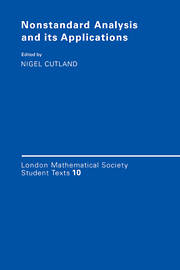Book contents
- Frontmatter
- Contents
- Preface
- Contributors
- AN INVITATION TO NONSTANDARD ANALYSIS
- INFINITESIMALS IN PROBABILITY THEORY
- INFINITESIMALS IN FUNCTIONAL ANALYSIS
- APPLICATIONS OF NONSTANDARD ANALYSIS IN MATHEMATICAL PHYSICS
- A LATTICE FORMULATION OF REAL AND VECTOR VALUED INTEGRALS
- AN APPLICATION OF NONSTANDARD METHODS TO COMPUTATIONAL GROUP THEORY
- SYNTACTICAL METHODS IN INFINITESIMAL ANALYSIS
- SOME ASYMPTOTIC RESULTS IN ORDINARY DIFFERENTIAL EQUATIONS
- SUPERINFINITESINALS AND INDUCTIVE LIMITS
- THE NON-LINEAR BOLTZMANN EQUATION FAR FROM EQUILIBRIUM
- INDEX
SYNTACTICAL METHODS IN INFINITESIMAL ANALYSIS
Published online by Cambridge University Press: 05 June 2012
- Frontmatter
- Contents
- Preface
- Contributors
- AN INVITATION TO NONSTANDARD ANALYSIS
- INFINITESIMALS IN PROBABILITY THEORY
- INFINITESIMALS IN FUNCTIONAL ANALYSIS
- APPLICATIONS OF NONSTANDARD ANALYSIS IN MATHEMATICAL PHYSICS
- A LATTICE FORMULATION OF REAL AND VECTOR VALUED INTEGRALS
- AN APPLICATION OF NONSTANDARD METHODS TO COMPUTATIONAL GROUP THEORY
- SYNTACTICAL METHODS IN INFINITESIMAL ANALYSIS
- SOME ASYMPTOTIC RESULTS IN ORDINARY DIFFERENTIAL EQUATIONS
- SUPERINFINITESINALS AND INDUCTIVE LIMITS
- THE NON-LINEAR BOLTZMANN EQUATION FAR FROM EQUILIBRIUM
- INDEX
Summary
INTRODUCTION
In (1977) Edward Nelson gave a new formulation of Abraham Robinson's Theory of Infinitesimals known as Internal Set. Theory. In (1980) Nelson refined this to give a solution to Robinson's (1973) Metamathematical Problem 11.
Nelson's approach to infinitesimal analysis has been taken up by a large number of workers in various fields. Lawler (1980) has obtained interesting results on a kind of self-avoiding random walk. The article by the Dieners below describes some of the many applications of Internal Set Theory to the study of differential equations. The article by Stroyan describes some extensions of Nelson's methods which are useful in topology and functional analysis. This article is an introduction to the ones by the Dieners and Stroyan.
This article is also a description of the common ground shared by the two approaches to Robinson's theory. We hope that our short presentation of 1ST and its interpretation in a superstructure will help those familiar with superstructures and those familiar with 1ST to understand each other.
In section 2 we give a brief introduction to 1ST (see references at the end for more complete introductions). In section 3 we restrict Nelson's methods to a superstructure as described above by Lindstrøm. This means that we only consider predicates from Nelson's formal language whose quantifiers are bounded by a standard entity. With this restriction, we shall prove in section 4 that Nelson's axiom schemes (I), (S) and (T) hold in a superstructure.
- Type
- Chapter
- Information
- Nonstandard Analysis and its Applications , pp. 258 - 281Publisher: Cambridge University PressPrint publication year: 1988
- 5
- Cited by



